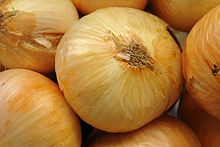Propanthialoxide
| Structural formula | ||||||||||
|---|---|---|---|---|---|---|---|---|---|---|

|
||||||||||
| Structural formula of the syn form | ||||||||||
| General | ||||||||||
| Surname | Propanthialoxide | |||||||||
| other names |
|
|||||||||
| Molecular formula | C 3 H 6 OS | |||||||||
| External identifiers / databases | ||||||||||
|
||||||||||
| properties | ||||||||||
| Molar mass | 90.14 g mol −1 | |||||||||
| safety instructions | ||||||||||
|
||||||||||
| As far as possible and customary, SI units are used. Unless otherwise noted, the data given apply to standard conditions . | ||||||||||
Propanthialoxide (more precisely Propanthial- S -oxide ) is a chemical compound and the only known naturally occurring thiocarbonyl - S -oxide. It occurs in two isomeric forms.
Natural origin
The compound is the onion tear irritant released from isoalliin by the enzyme alliinase ( Allium cepa ), of which approx. 95% is in the ( Z ) form.
If the onion injured arises from Isoalliin in the first step by cleavage of the Alaninfragmentes by the alliinase and the enzyme co-factor pyridoxal phosphate , the 1-Propensulfensäure represented by tautomeric hydrogen rearrangement to the so-called lachrymatory factor (engl. Lacrimatory factor , LF), the syn-propanethial-s-oxide in two isomeric forms ( syn- and anti - , wherein the) syn -form is the main product. This is very reactive and can hydrolyze to propionaldehyde , sulfuric acid and hydrogen sulfide , but can also enter into cycloadditions with itself to form four- and five-membered rings. At the higher temperatures of steam distillation at 100 ° C and of course when boiling or frying, dipropyl disulfide is formed in addition to propionaldehyde .
properties
Propanthialoxide hydrolyzes easily with water, releasing propionaldehyde , sulfuric acid and hydrogen sulfide .
Individual evidence
- ↑ This substance has either not yet been classified with regard to its hazardousness or a reliable and citable source has not yet been found.
- ↑ a b Gerhard Eisenbrand, Alfred Hagen Meyer, Peter Schreier: RÖMPP Lexikon Lebensmittelchemie, 2nd edition, 2006 . Georg Thieme, 2014, p. 2006 ( limited preview in Google Book Search).
- ↑ Wolfgang Legrum: Fragrances, Between Stench and Scent: Occurrence, Properties and Use of Fragrances and Their Mixtures . Springer-Verlag, 2011, p. 90 ( limited preview in Google Book search).

